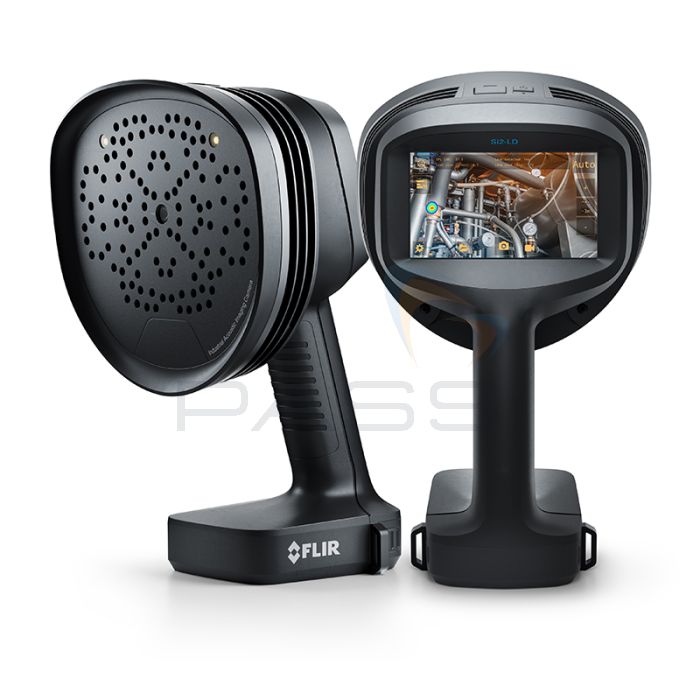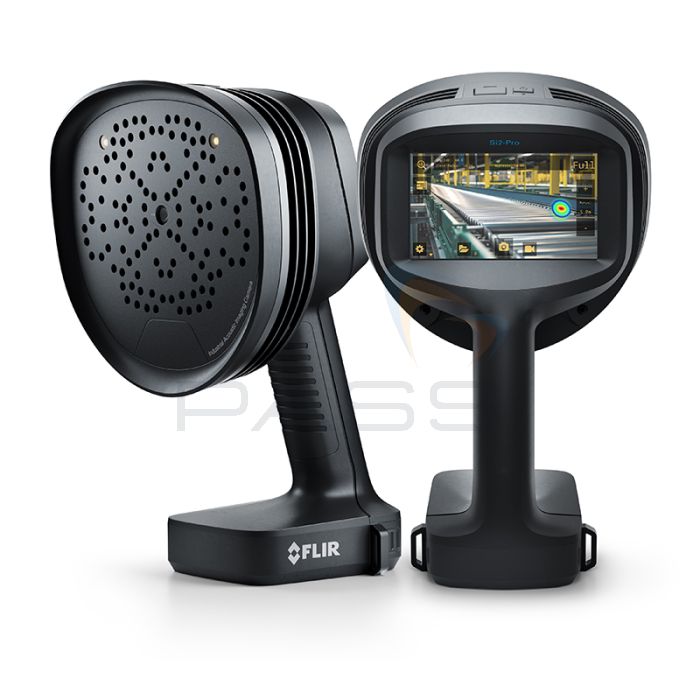
It is tempting to believe that acoustic cameras are only useful to manufacturing, utilities, and other industrial plants. Don’t be fooled. Like thermal technology, acoustic imaging also offers advantages to the arts and entertainment sectors. For instance, the Finnish National Opera and Ballet (FNOB) is already using FLIR’s Si2 Acoustic Imaging Camera to ensure the show goes on.[1]
Quick Links
- What Is an Acoustic Camera?
- Finnish National Opera & Ballet Improves Theatre Maintenance with Acoustic Imaging Camera
- Ladies & Gentlemen, The FLIR Si2 Acoustic Imaging Camera
- Further Information
What Is an Acoustic Camera?
Acoustic imaging cameras have long been familiar to industrial facilities. Still, they are only just making their theatre debut. This rising star of theatre maintenance enables teams to see ultrasonic sound emitted by compressed air leaks, partial discharge (a type of electrical fault found in high-voltage systems) and, crucially, faulty motors and bearings. This means maintenance teams can easily pinpoint faults, or impending faults, in machinery, circuits, and/or compressed air systems. Early fault detection ensures timely resolution, preventing issues from becoming costly, catastrophic failures that cause significant physical and reputational damage. This is of particular use to theatre maintenance teams responsible for complex stage machinery comprised of bearings, pulleys, motors, and other critical components.

How Does Acoustic Imaging Work?
Utilising an array of microphones, acoustic cameras capture ultrasonic vibrations emitted by faults or leaks. The camera then converts these vibrations into a visual representation, which it superimposes onto a digital image of the scene. As a result, maintenance personnel can see the source of the sound and, therefore, the location of the problem.
Some ultrasonic cameras also include sophisticated algorithms for assessing the severity of defects, for instance, categorising partial discharge problems or quantifying compressed air lost through leaks. Consequently, teams can evaluate the severity of issues quickly and make informed decisions about which faults need to be prioritised first.
Finnish National Opera & Ballet Improves Theatre Maintenance with Acoustic Imaging Camera

Built in Helsinki in 1993, the Finnish National Opera and Ballet (FNOB) stages approximately 500 performances a year to an annual audience of 250 000 theatre-goers. A pinnacle of the Finnish cultural landscape, the FNOB features specialised stage machinery that facilitates the artistic needs of contemporary performances. It enables, for example, complex scene transitions. Theatre technicians must operate systems and machinery safely and with faultless precision to deliver seamless performances night after night. That means everything must be in perfect working condition. A mammoth and unenviable responsibility that falls on the theatre’s maintenance crew.
Towering Heights & Tight Spaces Make Theatre Maintenance Tricky
The FNOB is 40 000 sqm. Two hundred motors, comprising thousands of bearings, rollers, and other mechanical components, operate the main stage alone. All are potential sources of problems. In addition to this, the FNOB features enormous moving floor elements that each weigh up to 10 000 kg, towering set pieces, and intricate pulley systems. A lot of the theatre’s equipment, systems, and machinery is kept in tight, hard-to-reach areas, potentially several metres above or below the stage. Plus, to make the task trickier, major maintenance and repairs must be completed during the opera house’s short off-season. Therefore faults have to be detected, assessed, prioritised, and scheduled for repair in time for this narrow window.
Maintenance Challenges Common to Premier Performing Arts Venues
The Finnish National Opera and Ballet isn't the only theatre to face significant maintenance obstacles. When it comes to delivering effective theatre maintenance, many premier performing arts venues encounter the following problems.
| Maintenance Challenge | Impact |
| Confined and Hard-to-Reach Spaces | Tight and difficult-to-access spaces make inspections and repairs difficult. |
| Massive Moving Elements | Specialised equipment is needed to inspect heavy stage components. |
| High-Altitude Work | Overhead rigging, lighting, and set pieces require inspection and are often installed at significant heights. |
| Complex Stage Machinery | There are many moving parts in complex stage machinery, such as motors, pulleys, and bearings, all of which must operate flawlessly. |
| Limited Maintenance Windows | Repairs have to be scheduled and completed during the short off-season. |
| Precision and Reliability | Even small mechanical failures can disrupt performances and impact artistic integrity. |
| Safety Risks | Theatres often house unique structures and heavy elements in confined spaces that may be several metres above or below stage level. |
| Continuous Monitoring Needs | Preventing breakdowns requires proactive and continuous tracking of equipment and system health. |
FLIR Si2 Acoustic Imaging Camera Revolutionises Theatre Maintenance Schedule

As outlined, the Finnish National Opera and Ballet’s maintenance team required an inspection tool that would help them to assess the health of specialised machinery, pulley systems, floor elements, and set pieces easily, efficiently, and precisely. FLIR, a leading thermal and acoustic imaging manufacturer, was able to provide a solution: the FLIR Si2 Acoustic Camera with Mechanical Mode.
The FLIR Si2 Acoustic Imaging Camera allows the FNOB’s maintenance team to detect defects and developing issues from a safe, comfortable distance, and, crucially, before they become expensive, performance-halting failures.
Capable of finding faults without direct contact, the Si2 is ideal for inspecting the condition of systems, machinery, and equipment in tight spaces such as beneath the stage or on high-altitude rigging systems. Moreover, its innovative Mechanical Mode analyses sound patterns to determine whether faults are likely due to friction, wear, or the misalignment of bearings and/or other moving parts. Remotely identifying issues allows the theatre maintenance crew to make informed decisions about the urgency of repairs. This helps the FNOB avoid unexpected breakdowns, minimise downtime, and ensure intricate stage machinery operates flawlessly, contributing to seamless performances every night.
Speaking to FLIR, the Finnish National Opera and Maintenance team reports that:
“[…] the Si2 acoustic camera not only speeds up their work by swiftly pinpointing the precise location of the issue from a distance, but also removes guesswork from repairs – a trait much appreciated when dismantling a part of a unique structure requires a special hoist to be ordered on-site.”[2]
In addition to improving the precision and ease of inspections, FNOB’s maintenance crew explained to FLIR that the Si2 enables them to save money on repairs and replacements by maximising the lifespan of existing equipment:
“It [the FLIR Si2 Acoustic Imaging Camera] also allows for consistent monitoring and maintenance of an identified issue in an effort to optimise the lifespan of expensive parts, like in the case of a bearing emitting abnormal noise in a hard-to-reach light bridge that costs tens of thousands to replace.”[3]
The FLIR Si2 also reduces maintenance costs by guiding third-party service crews directly to the problem and providing an initial assessment of the fault. This eliminates the need for time-consuming and expensive inspections and means repairs can be completed quickly during the limited off-season.
The Show Must Go On!
Another key advantage of the FLIR Si2 Acoustic Camera is that when a theatre technician reports an issue, it can be inspected, assessed, and addressed quickly. For example, an FNOB technician reported an issue with the stage curtain. Using the FLIR Si2, the maintenance crew discovered the problem was due to a faulty bearing 15m above the stage. The problem was immediately rectified, ensuring subsequent shows could go on free of disturbance.

Ladies & Gentlemen, The FLIR Si2 Acoustic Imaging Camera
FLIR, a leading manufacturer of both thermal and acoustic cameras, has developed a comprehensive range of ultrasonic imagers. This collection includes the FLIR Si2 series. The FLIR Si2-LD and FLIR Si2-Pro are ideal for theatre maintenance because both include a Mechanical Fault mode for identifying problems with bearings, friction, wear, and misalignment.
What Are the Benefits of Using a FLIR Si2 Acoustic Camera for Theatre Maintenance?
| FLIR Si2 Advantage | Theatre Maintenance Benefits |
| Early Fault Detection and Analysis | Identify and analyse bearing wear, misalignment, and friction before they result in costly failures. |
| Non-contact Inspection | Assess components from a safe and comfortable distance. |
| Access Hard-to-Reach Areas | Detect mechanical issues in tight spaces beneath the stage and on high-altitude rigging systems without dismantling equipment. |
| Enables Predicitve Maintenance | Reduces the risk of sudden breakdowns and minimises downtime, helping performances run seamlessly. |
| Enhanced Safety | Overhead stage structures and confined machinery zones are high-risk areas; the FLIR Si2 limits the need for maintenance staff to work in these areas. |
| Delivers Dependable Data | Reliable acoustic imaging and data enable targeted, efficient maintenance to take place during the short off-season. |
| Optimised Performance | Ensures thousands of moving parts function seamlessly, keeping set changes, lifts, and stage movements flawless night after night. |
| Faster Emergency Response | When theatre technicians report an issue during/after a show, the FLIR Si2 can be used to identify and assess the problem, ensuring it can be addressed quickly and appropriately. |
| Mechanical Mode | Analyses sound patterns to determine whether faults are due to friction, wear, or the misalignment of bearings and/or other moving parts; accurate identification facilitates targeted maintenance and prevents performance disruptions. |
| Reduced Maintenance Costs | Helps lower expenses by guiding external service teams directly to the faulty component, eliminating the need for costly full inspections. |
Further Information
You can read more about the Finnish National Opera and Ballet’s integration of the FLIR Si2 Acoustic Camera into their theatre maintenance schedule on Teledyne FLIR’s website.
Alternatively, for more information about the benefits and applications of acoustic imaging, please consult our collection of case studies.
Read Acoustic Camera Case Studies
Finally, for additional details on acoustic imaging cameras, including FLIR’s Si Series, please contact our Sales team on 01642 931 329 or via our online form.
In the meantime, you can find out more about FLIR’s acoustic cameras on our website, tester.co.uk.
Discover FLIR Acoustic Imaging Cameras
Learn More About the FLIR Si2-LD Acoustic Camera
More Information About the FLIR Si2-Pro Acoustic Camera
Footnotes
[1] The following source provided information about the Finnish National Opera and Ballet’s use of the FLIR Si2 Acoustic Imaging Camera:
- Teledyne FLIR, Behind the Scenes: How Acoustic Imaging Technology is Helping the Finnish National Opera and Ballet Run Smoothly, last accessed 24th July 2025
[2] Teledyne FLIR, Behind the Scenes: How Acoustic Imaging Technology is Helping the Finnish National Opera and Ballet Run Smoothly.
[3] Teledyne FLIR, Behind the Scenes: How Acoustic Imaging Technology is Helping the Finnish National Opera and Ballet Run Smoothly.




